More than half of the people who responded to a council consultation “strongly disagreed” with a proposal for “open admissions” policy at Brighton and Hove secondary schools.
In total, almost 4,000 people responded to Brighton and Hove City Council’s eight-week consultation on proposed changes to secondary school admissions rules from September next year.
The proposals will be voted on at a special meeting of the full council on Thursday 27 February. They include
• allocating up to 5 per cent of places through open admission
• increase the percentage of children eligible for free school meals who are given priority admissions
• reduce admissions at Blatchington Mill, Dorothy Stringer and Longhill
• widen choice by allowing four preferences instead of when applying for secondary school
The “open admissions” proposals has proved to be the most controversial, with the council planning to set aside 5 per cent of places for children from single-school catchment areas.
The open admissions policy would have sixth priority. The first five are
1 Children in care or who were previously looked after by the local authority
2 Medical need
3 Sibling link
4 Children eligible for free school meals living in the catchment area
5 Children eligible for free school meals living outside the catchment
The open admissions policy would apply to those living in the single-school catchment areas for BACA, PACA, Patcham High and Longhill. It would give children more of a chance of a place at a school outside their catchment area.
Before the consultation, council documents said that an open admissions policy of up to 20 per cent could mean that 250 children in the catchments for Dorothy Stringer and Varndean and for Hove Park and Blatchington Mill would be unable to have a place at their local school.
A report published yesterday (Wednesday 19 February) asked councillors to permit 5 per cent of places in dual school catchment areas to be set aside for open admissions.
The report also revised a council forecast of how many children in the Dorothy Stringer and Varndean catchment could be sent to schools out of the area down from 144 to 54. At both schools, 34 per cent of pupils are expected to be eligible for free school meals.
No children are expected to miss out on places at Blatchington Mill or Hove Park under the 5 per cent criteria.
Even though Patcham High is in a single-school catchment, the report said that nine children in the area might not be given a place at the school. A quarter of pupils are forecast to be eligible for free school meals.
The report analysed the 3,836 consultation responses, 300 emails and one letter and included a summary of comments.
Open admissions
In all, 60 per cent disagreed with the open admissions proposal, including 51.5 per cent who strongly disagreed, while 33 per cent were in favour, including 25.4 per cent who strongly agreed.
In response to another survey question on the same subject, 40 per cent – or 1,642 people – said that they did not agree with the proposal when asked what percentage of open admissions they would support.
• Do not agree with open admissions 40 per cent (1,642 responses)
• Allocation for 30 per cent of places to open admission 19.5 per cent (798 responses)
• Allocation for less than 5 per cent of places to open admission 12.5 per cent (513 responses)
• Allocation for 20 per cent of places to open admission 9.3 per cent (381 responses)
• Allocation of 5 per cent of places to open admission 6.1 per cent (251 responses)
• Allocation of 10 per cent of places to open admission 5.7 per cent (235 responses)
• Prefer not to say 4 per cent (165 responses)
• Other 2.5 per cent (103 responses)
It was the question that received the most written responses – from 1,078 people.
The report said: “Some respondents believe that the changes could disadvantage children in dual catchment areas as they may have less chance of getting into their local schools.
“This was accompanied by questions on whether it was unjust to prioritise children from outside the catchment area over those that live within it.
“There are also concerns that the changes could lead to a loss of parental choice and control over their children’s education.
“Others argue that the changes could exacerbate existing inequalities, as children from more affluent areas may still have more choices than those from disadvantaged backgrounds.
“There were also comments questioning whether there would be unintended consequences such as people leaving the city or not taking up the offer of other schools in the city.
“Some felt there was a lack of clear evidence supporting the effectiveness of the proposed changes and the potential for increased absenteeism and associated reduced educational attainment.
“Several comments highlight the potential negative impact on specific groups of children. For instance, there are concerns that children with special educational needs (SEN) could be disproportionately affected by the changes.
“However, positive feedback was also received for this proposal. There was appreciation for the efforts to give children from less advantaged areas of the city a choice of schools and a belief that the proposals could create a more mixed and diverse school system.
“There are also comments that highlight the potential benefits of the changes for specific groups. For example, children from ‘council estates’ having the same opportunities at other children in the city.
“Other comments were about the increased opportunity for some families not eligible for free school meals but living in single-school catchment areas.
“There were calls from some for a more gradual approach, starting with a lower percentage for open admissions and assessing the impact of existing changes before introducing new ones.”
More preferences
The second highest number of written responses was to the council’s proposals to increase the number of choices or preferences on the admissions application form from three to four.
With 43 per cent either disagreeing or strongly disagreeing, some of the 801 written responses said that the proposals gave an “illusion of choice”.
They were concerned that the change was designed to enable the council “to manipulate statistics rather providing meaningful choices”.
The report said: “Several felt that the additional preference is a way for the council to claim that more people received one of their preferred schools, even if it’s not truly preferred.
“There were comments around how the overall proposals meant that parental ‘choice’ was being limited and not expanded as is implied.”
Free school meals
An adjustment to the council’s new policy on prioritising pupils receiving free school meals had 658 responses.
Last year councillors agreed to introduce a policy to give greater priority to children who were eligible for free school meals.
Currently, 26.3 per cent of secondary school pupils on average in Brighton and Hove are eligible for free school meals. The policy gives priority up to that percentage.
The proposed change would increase the proportion to 30 per cent.
Some 40 per cent disagreed or strongly disagreed with the proposal while 35.4 per cent agreed or strongly agreed and 20.8 per cent neither agreed nor disagreed.
There were 658 written responses, many showing support for the aim of promoting fairness.
Some respondents questioned the setting of a quota and others were concerned that some schools might end up with a disproportionate number of pupils receiving free school meals, limiting the social mix.
While 26.3 per cent were eligible for free school meals at Brighton and Hove secondary schools as of last month, the figure at individual schools varies between 19.1 per cent and 49.1 per cent.
Six of the 10 secondaries have fewer pupils than average who are eligible for free school meals while at BACA and Longhill the figure is more than 40 per cent.
Reduced intakes
Governors at Dorothy Stringer and Longhill backed a proposed reduction in the published admission number (PAN) at their schools.
Parents and carers of Longhill children broadly agreed with the school’s governors. But 60 per cent of Dorothy Stringer parents disagreed with the proposal, with 799 providing a written response.
People were concerned that reducing the PAN would affect children’s chances of attending their local school, given the catchment area could change and some places would be reserved for open admissions.
Governors and parents opposed a proposal to reduce the intake – or PAN – at Blatchington Mill by one form of entry, equal to 30 children.
There were 588 written responses, with some asking why the council would want to reduce the intake at such a popular and well-performing school.
There was also opposition to a proposal to take much of Whitehawk from the Longhill catchment and to include it in the Dorothy Stringer and Varndean catchment – and to include Kemp Town in the Longhill catchment rather than the Dorothy Stringer and Varndean catchment.
The 758 written responses raised concerns about additional pressure on the two oversubscribed schools as well as the cost of travel from Whitehawk and longer travel times.
Some said that they were in favour because the move improved access to “high-performing schools for children from deprived areas”.
Consultation background
During the consultation process, the council held four public meetings attended by more than 400 people. A further eight meetings were held for families at primary and secondary schools.
The Parent Carers’ Council (PaCC) and the Hangleton and Knoll Project also hosted events.
Parent and carers sent 3,012 responses. The highest number, 1,698, came from the BN1 area. Of these 819 were from BN1 6 which includes Preston, Withdean, Patcham, Hollingbury, Coldean, Stanmer and Falmer.
The second highest number of responses, 1,452, came from the BN2 area, with 431 from Bevendean, Moulsecoomb, Woodingdean, Brighton Marina, Ovingdean, Rottingdean and Saltdean.
Residents in the BN3 postcode area, which covers Hove, sent 317 responses, and 55 came in from the BN41 area – Portslade.
The special council meeting is due to start at 3pm on Thursday 27 February at Hove Town Hall. The meeting is scheduled to be webcast on the council’s website.










Why not aim to improve the education level across all schools in the area. A key part of that is the quality of the teaching. Why not facilitate best practices and results across schools? Perhaps some mentoring, knowledge and time shared by the best teachers? If done well, could be interesting and motivating to teachers and deliver tangible benefits for pupils across the city.
Not surprised there are divisions. Can’t see parents of children at Varndean or Blatch Mill and the other ” superior” schools being to keen to see “estate” kids turning up. I agree with Nick, improve the education at all schools.